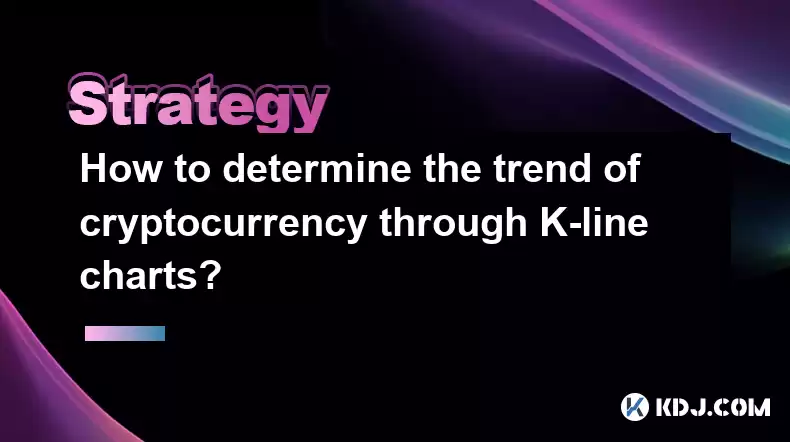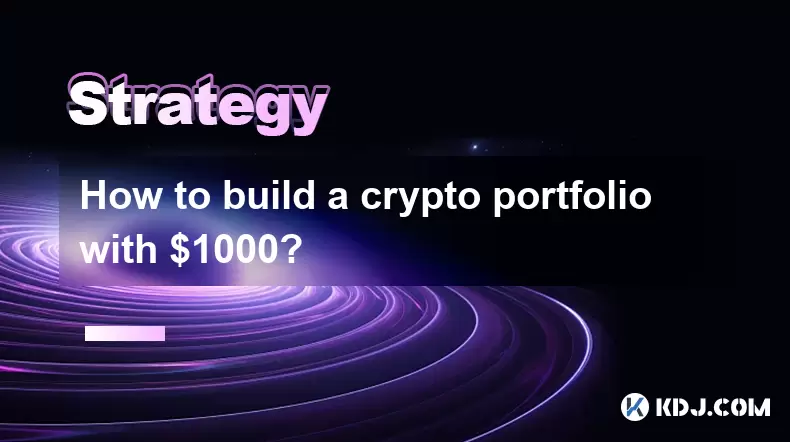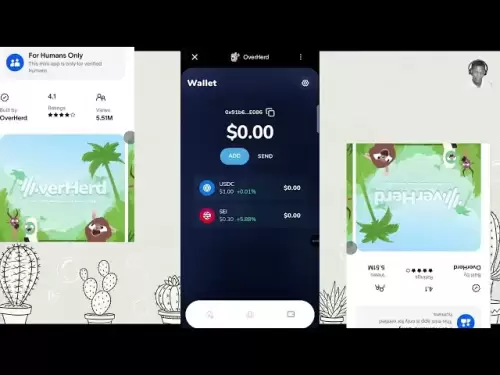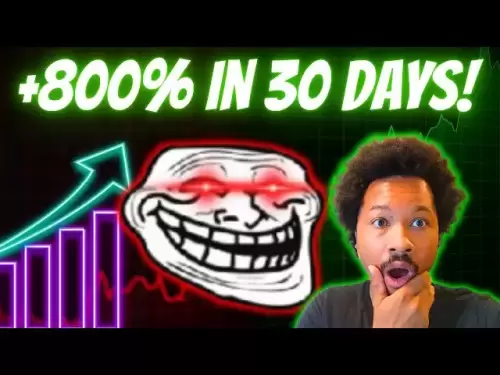-
 Bitcoin
Bitcoin $114200
-0.03% -
 Ethereum
Ethereum $3649
-0.25% -
 XRP
XRP $2.963
-2.31% -
 Tether USDt
Tether USDt $0.9997
-0.02% -
 BNB
BNB $761.0
-0.17% -
 Solana
Solana $164.6
-2.06% -
 USDC
USDC $0.9997
-0.02% -
 TRON
TRON $0.3321
-0.45% -
 Dogecoin
Dogecoin $0.2010
-2.49% -
 Cardano
Cardano $0.7282
-2.60% -
 Hyperliquid
Hyperliquid $37.56
-2.50% -
 Stellar
Stellar $0.3935
-3.18% -
 Sui
Sui $3.440
-1.36% -
 Chainlink
Chainlink $16.49
-1.80% -
 Bitcoin Cash
Bitcoin Cash $558.0
-1.38% -
 Hedera
Hedera $0.2407
-1.49% -
 Avalanche
Avalanche $22.27
-2.29% -
 Ethena USDe
Ethena USDe $1.001
0.00% -
 Litecoin
Litecoin $118.6
-4.00% -
 UNUS SED LEO
UNUS SED LEO $8.995
0.02% -
 Toncoin
Toncoin $3.190
-5.11% -
 Shiba Inu
Shiba Inu $0.00001214
-1.51% -
 Uniswap
Uniswap $9.655
-1.88% -
 Polkadot
Polkadot $3.638
-0.50% -
 Monero
Monero $292.1
-1.82% -
 Dai
Dai $1.000
-0.03% -
 Bitget Token
Bitget Token $4.312
-0.90% -
 Cronos
Cronos $0.1389
-0.32% -
 Pepe
Pepe $0.00001026
-2.44% -
 Aave
Aave $258.2
-1.12%
How to determine the trend of cryptocurrency through K-line charts?
K-line charts are essential for crypto trading, showing price trends via candlesticks; use with other indicators for better predictions and always manage risk.
Apr 01, 2025 at 04:21 pm

Understanding K-Line Charts in Cryptocurrency Trading
K-line charts, also known as candlestick charts, are a fundamental tool for technical analysis in cryptocurrency trading. They visually represent price movements over a specific period, providing insights into buying and selling pressure. Each candlestick represents the opening, closing, high, and low prices within that timeframe (e.g., 1-minute, 1-hour, 1-day). Understanding how to interpret these elements is crucial for predicting trends. The body of the candlestick shows the difference between the opening and closing prices, while the "wicks" (or shadows) extend to the high and low prices of the period.
Identifying Uptrends Using K-Line Charts
An uptrend is characterized by a series of higher highs and higher lows. On a K-line chart, this manifests as a succession of green (or bullish) candlesticks, each closing higher than the previous one. While occasional red (or bearish) candles might appear, they should be relatively small and contained within the overall upward trajectory. Look for long green candlesticks with small lower wicks, indicating strong buying pressure. The longer the green body, the stronger the bullish signal.
Identifying Downtrends Using K-Line Charts
A downtrend is the opposite of an uptrend, featuring lower highs and lower lows. This is depicted on a K-line chart as a series of red candlesticks, each closing lower than the previous one. Small green candles within the downtrend are considered weak bullish signals and are usually quickly overcome by bearish pressure. Pay close attention to long red candlesticks with short upper wicks, indicating strong selling pressure.
Identifying Support and Resistance Levels
Support levels represent price points where buying pressure is strong enough to prevent further price declines. On a chart, support is often identified as a horizontal line where the price repeatedly bounces off. Resistance levels are the opposite – price points where selling pressure is strong enough to prevent further price increases. Breakouts above resistance or below support often signal significant trend changes.
Using Moving Averages to Confirm Trends
Moving averages smooth out price fluctuations, making it easier to identify trends. Commonly used moving averages include the 50-day and 200-day moving averages. A bullish trend is often confirmed when the price is above both the 50-day and 200-day moving averages. Conversely, a bearish trend is confirmed when the price is below both moving averages. A "golden cross" (50-day MA crossing above the 200-day MA) is a bullish signal, while a "death cross" (50-day MA crossing below the 200-day MA) is a bearish signal.
Recognizing Candlestick Patterns
Certain candlestick patterns can provide valuable insights into potential trend reversals or continuations. For example:
- Hammer: A small body with a long lower wick, suggesting a potential bottom and bullish reversal.
- Hanging Man: Similar to a hammer but appears at the top of an uptrend, suggesting a potential top and bearish reversal.
- Engulfing Pattern: A large candlestick engulfing a smaller one, indicating a potential trend reversal. A bullish engulfing pattern occurs when a green candle completely engulfs a preceding red candle, while a bearish engulfing pattern is the opposite.
- Doji: A candlestick with virtually equal opening and closing prices, suggesting indecision in the market.
Combining Indicators for Stronger Signals
Relying solely on K-line charts can be misleading. Combining K-line analysis with other technical indicators, such as RSI (Relative Strength Index), MACD (Moving Average Convergence Divergence), and volume analysis, can provide a more comprehensive picture and improve the accuracy of your trend predictions. Never rely on a single indicator for trading decisions.
Timeframe Considerations
The timeframe you choose for your K-line chart significantly impacts your analysis. Shorter timeframes (e.g., 1-minute, 5-minute) reveal short-term price fluctuations and are suitable for day trading. Longer timeframes (e.g., daily, weekly) provide a broader perspective on the overall trend. Analyzing multiple timeframes can help you identify both short-term trading opportunities and long-term investment strategies.
Risk Management is Crucial
No matter how skilled you become at interpreting K-line charts, remember that cryptocurrency markets are inherently volatile. Always implement proper risk management techniques, such as setting stop-loss orders and diversifying your portfolio, to protect your capital. Never invest more than you can afford to lose.
Frequently Asked Questions
Q: Are K-line charts reliable for predicting cryptocurrency trends?
A: K-line charts are a valuable tool for technical analysis, but they don't guarantee accurate predictions. They should be used in conjunction with other indicators and risk management strategies. Market sentiment, news events, and regulatory changes can all significantly impact cryptocurrency prices, regardless of what the K-line charts suggest.
Q: What are the limitations of using K-line charts alone?
A: K-line charts primarily focus on price action. They don't consider fundamental factors like market capitalization, adoption rates, or technological advancements, which can also influence price movements. Using K-lines alone might lead to missing crucial information impacting the cryptocurrency's value.
Q: How can I improve my K-line chart interpretation skills?
A: Practice is key. Start by analyzing historical charts of various cryptocurrencies. Experiment with different timeframes and indicators. Consider using charting platforms with educational resources and backtesting capabilities to refine your skills. Observe how experienced traders interpret charts and learn from their analysis. Remember to always practice on a demo account before risking real capital.
Q: What other tools should I use alongside K-line charts?
A: Many other tools complement K-line charts. These include volume analysis (to confirm price movements), moving averages (to smooth price data and identify trends), RSI (to gauge momentum), MACD (to identify trend changes), and Bollinger Bands (to measure volatility). Combining these tools with K-line charts allows for a more holistic understanding of the market.
Q: Can I use K-line charts to predict short-term price spikes?
A: While you can identify potential short-term price movements using K-line charts combined with other indicators, predicting precise price spikes is extremely difficult and unreliable. The cryptocurrency market is highly susceptible to rapid and unpredictable changes, making precise short-term predictions nearly impossible. Focus on identifying overall trends and potential reversal points rather than precise price targets.
Disclaimer:info@kdj.com
The information provided is not trading advice. kdj.com does not assume any responsibility for any investments made based on the information provided in this article. Cryptocurrencies are highly volatile and it is highly recommended that you invest with caution after thorough research!
If you believe that the content used on this website infringes your copyright, please contact us immediately (info@kdj.com) and we will delete it promptly.
- Coinbase, Financing, and the Crypto Market: Navigating Choppy Waters in NYC Style
- 2025-08-06 12:50:11
- Bitcoin in Indonesia: Crypto Education and Economic Strategy
- 2025-08-06 12:50:11
- DeriW Mainnet: Zero Gas Fees Revolutionize On-Chain Derivatives Trading
- 2025-08-06 10:30:11
- IOTA, Cloud Mining, and Eco-Friendly Crypto: A New York Investor's Take
- 2025-08-06 10:30:11
- Kaspa (KAS) Price Prediction: August 6 - Will It Break Free?
- 2025-08-06 10:50:12
- Pension Funds, Bitcoin ETFs, and Exposure: A New Era of Institutional Crypto Adoption
- 2025-08-06 12:55:12
Related knowledge

How to avoid common crypto investment mistakes?
Jul 13,2025 at 01:35am
Understanding the Risks of Crypto InvestmentInvesting in cryptocurrency can be highly rewarding, but it also comes with significant risks. One of the ...

What is a long-short crypto strategy?
Jul 15,2025 at 10:56am
Understanding the Basics of a Long-Short Crypto StrategyA long-short crypto strategy is an investment approach where traders simultaneously take long ...

What is a long-short crypto strategy?
Jul 11,2025 at 01:28pm
Understanding the Basics of Long-Short Crypto StrategyA long-short crypto strategy is an investment approach where traders take both long and short po...

How to use the RSI indicator for crypto?
Jul 12,2025 at 03:56pm
Understanding the RSI Indicator in Cryptocurrency TradingThe Relative Strength Index (RSI) is a momentum oscillator used to measure the speed and chan...

Is copy trading a good strategy for crypto beginners?
Jul 12,2025 at 08:28am
Understanding Copy Trading in the Cryptocurrency MarketCopy trading is a strategy where novice traders replicate the trades of experienced investors a...

How to build a crypto portfolio with $1000?
Jul 13,2025 at 08:14pm
Understanding the Basics of Cryptocurrency InvestmentBuilding a crypto portfolio with $1000 starts with understanding the fundamentals of cryptocurren...

How to avoid common crypto investment mistakes?
Jul 13,2025 at 01:35am
Understanding the Risks of Crypto InvestmentInvesting in cryptocurrency can be highly rewarding, but it also comes with significant risks. One of the ...

What is a long-short crypto strategy?
Jul 15,2025 at 10:56am
Understanding the Basics of a Long-Short Crypto StrategyA long-short crypto strategy is an investment approach where traders simultaneously take long ...

What is a long-short crypto strategy?
Jul 11,2025 at 01:28pm
Understanding the Basics of Long-Short Crypto StrategyA long-short crypto strategy is an investment approach where traders take both long and short po...

How to use the RSI indicator for crypto?
Jul 12,2025 at 03:56pm
Understanding the RSI Indicator in Cryptocurrency TradingThe Relative Strength Index (RSI) is a momentum oscillator used to measure the speed and chan...

Is copy trading a good strategy for crypto beginners?
Jul 12,2025 at 08:28am
Understanding Copy Trading in the Cryptocurrency MarketCopy trading is a strategy where novice traders replicate the trades of experienced investors a...

How to build a crypto portfolio with $1000?
Jul 13,2025 at 08:14pm
Understanding the Basics of Cryptocurrency InvestmentBuilding a crypto portfolio with $1000 starts with understanding the fundamentals of cryptocurren...
See all articles

























































































